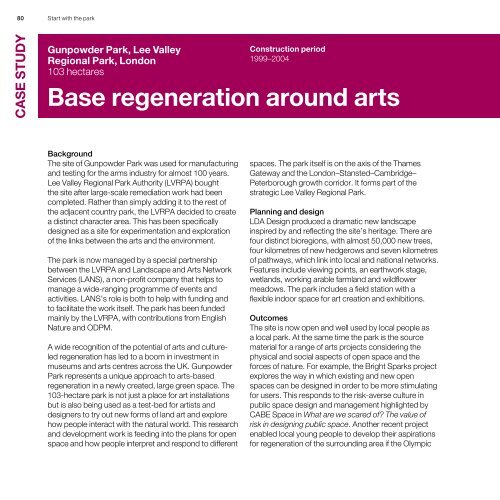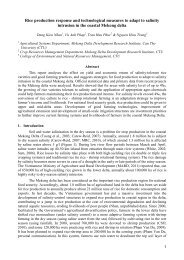start-with-the-park
Create successful ePaper yourself
Turn your PDF publications into a flip-book with our unique Google optimized e-Paper software.
80 Start <strong>with</strong> <strong>the</strong> <strong>park</strong><br />
CASE STUDY<br />
Gunpowder Park, Lee Valley<br />
Regional Park, London<br />
103 hectares<br />
Construction period<br />
1999–2004<br />
Base regeneration around arts<br />
Background<br />
The site of Gunpowder Park was used for manufacturing<br />
and testing for <strong>the</strong> arms industry for almost 100 years.<br />
Lee Valley Regional Park Authority (LVRPA) bought<br />
<strong>the</strong> site after large-scale remediation work had been<br />
completed. Ra<strong>the</strong>r than simply adding it to <strong>the</strong> rest of<br />
<strong>the</strong> adjacent country <strong>park</strong>, <strong>the</strong> LVRPA decided to create<br />
a distinct character area. This has been specifically<br />
designed as a site for experimentation and exploration<br />
of <strong>the</strong> links between <strong>the</strong> arts and <strong>the</strong> environment.<br />
The <strong>park</strong> is now managed by a special partnership<br />
between <strong>the</strong> LVRPA and Landscape and Arts Network<br />
Services (LANS), a non-profit company that helps to<br />
manage a wide-ranging programme of events and<br />
activities. LANS’s role is both to help <strong>with</strong> funding and<br />
to facilitate <strong>the</strong> work itself. The <strong>park</strong> has been funded<br />
mainly by <strong>the</strong> LVRPA, <strong>with</strong> contributions from English<br />
Nature and ODPM.<br />
A wide recognition of <strong>the</strong> potential of arts and cultureled<br />
regeneration has led to a boom in investment in<br />
museums and arts centres across <strong>the</strong> UK. Gunpowder<br />
Park represents a unique approach to arts-based<br />
regeneration in a newly created, large green space. The<br />
103-hectare <strong>park</strong> is not just a place for art installations<br />
but is also being used as a test-bed for artists and<br />
designers to try out new forms of land art and explore<br />
how people interact <strong>with</strong> <strong>the</strong> natural world. This research<br />
and development work is feeding into <strong>the</strong> plans for open<br />
space and how people interpret and respond to different<br />
spaces. The <strong>park</strong> itself is on <strong>the</strong> axis of <strong>the</strong> Thames<br />
Gateway and <strong>the</strong> London–Stansted–Cambridge–<br />
Peterborough growth corridor. It forms part of <strong>the</strong><br />
strategic Lee Valley Regional Park.<br />
Planning and design<br />
LDA Design produced a dramatic new landscape<br />
inspired by and reflecting <strong>the</strong> site’s heritage. There are<br />
four distinct bioregions, <strong>with</strong> almost 50,000 new trees,<br />
four kilometres of new hedgerows and seven kilometres<br />
of pathways, which link into local and national networks.<br />
Features include viewing points, an earthwork stage,<br />
wetlands, working arable farmland and wildflower<br />
meadows. The <strong>park</strong> includes a field station <strong>with</strong> a<br />
flexible indoor space for art creation and exhibitions.<br />
Outcomes<br />
The site is now open and well used by local people as<br />
a local <strong>park</strong>. At <strong>the</strong> same time <strong>the</strong> <strong>park</strong> is <strong>the</strong> source<br />
material for a range of arts projects considering <strong>the</strong><br />
physical and social aspects of open space and <strong>the</strong><br />
forces of nature. For example, <strong>the</strong> Bright S<strong>park</strong>s project<br />
explores <strong>the</strong> way in which existing and new open<br />
spaces can be designed in order to be more stimulating<br />
for users. This responds to <strong>the</strong> risk-averse culture in<br />
public space design and management highlighted by<br />
CABE Space in What are we scared of? The value of<br />
risk in designing public space. Ano<strong>the</strong>r recent project<br />
enabled local young people to develop <strong>the</strong>ir aspirations<br />
for regeneration of <strong>the</strong> surrounding area if <strong>the</strong> Olympic





